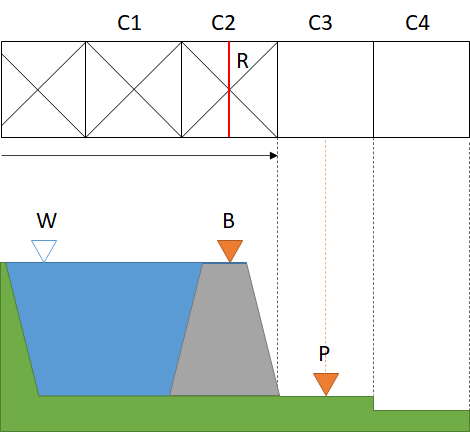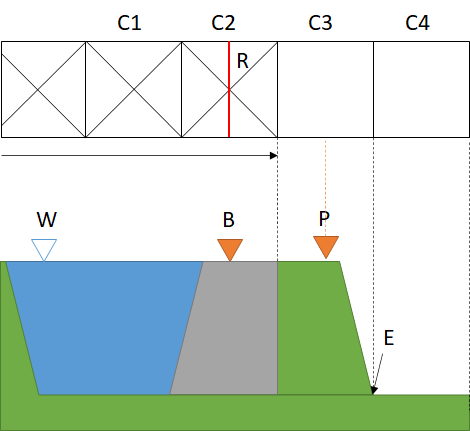FAQ/ Should the Left Bank Line and Right Bank Line be Defined on the Embankment?¶
Where should the Left Bank Line and Right Bank Line be defined? Is it on the embankment?
response¶
It is on the embankment.
However, if you are analyzing a river with a huge embankment, it is recommended to set it to the inner side of the embankment. A massive embankment is one whose width is many times larger than the mesh size.
Figure 1 shows an example where the problem does not occur.
Above cell C2 drew the right bank line R. Cells C1 and C2 are river channels, and cells C3 and C4 are floodplains. When a levee breaks, the river channel water level W is higher than the ground height P of cell C3 in the floodplain, so it flows out into the floodplain. In the figure, the gray area is the levee lost due to the levee. This is the behavior that the user expects.
 Figure 1: Example of expected behavior
Figure 1: Example of expected behavior
Figure 2 shows an example of what goes wrong.
As in Figure 1, we drew the right bank line R over cell C2. As in Figure 1, cells C1 and C2 are river channels and cells C3 and C4 are floodplains. However, unlike Figure 1, the embankment is wide, so not only cell C2 but also cell C3 is on the top of the embankment. When a levee break, the gray part in the figure is the part lost due to the levee. In other words, a part of the embankment on the floodplain side (cell C3) is evaluated as if it remains, and even if it breaks, it will not flow out into the floodplain (it does not flow out into the floodplain because the river channel water level W is lower than the ground height P of cell C3 in the floodplain).
This is behavior that users do not expect. The reason for this is that the top of the embankment, which should have been treated as a river channel, is treated as a floodplain. Draw a right bank line so that cell C3 is the river channel. In the figure, if you draw a right bank line on the court butt E, this problem does not occur.
 Figure 2: Example of not expected behavior
Figure 2: Example of not expected behavior